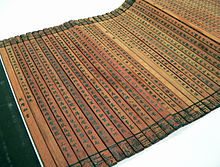
Back Die krygskuns Afrikaans Die Kunst des Krieges (Sunzi) ALS L'arte d'a guerra AN فن الحرب Arabic لفن د لحرب ARY দ্য আৰ্ট অফ ৱাৰ Assamese Sūnzĭ Bīngfǎ AST Müharibə sənəti Azerbaijani Һуғыш сәнғәте Bashkir Seni Mayuda BAN
 | |||||||||||||||||||||||||||||
| Author | Sun Tzu (traditional) | ||||||||||||||||||||||||||||
|---|---|---|---|---|---|---|---|---|---|---|---|---|---|---|---|---|---|---|---|---|---|---|---|---|---|---|---|---|---|
| Language | Classical Chinese | ||||||||||||||||||||||||||||
| Subject | Military art | ||||||||||||||||||||||||||||
| Genre | Military strategy | ||||||||||||||||||||||||||||
Publication date | 5th century BC | ||||||||||||||||||||||||||||
| Publication place | China | ||||||||||||||||||||||||||||
| 355.02 | |||||||||||||||||||||||||||||
| LC Class | U101 .S95 | ||||||||||||||||||||||||||||
Original text | The Art of War at Chinese Wikisource | ||||||||||||||||||||||||||||
| Translation | The Art of War at Wikisource | ||||||||||||||||||||||||||||
| Chinese name | |||||||||||||||||||||||||||||
| Traditional Chinese | 孫子兵法 | ||||||||||||||||||||||||||||
| Simplified Chinese | 孙子兵法 | ||||||||||||||||||||||||||||
| Literal meaning | "Master Sun's Military Methods" | ||||||||||||||||||||||||||||
| |||||||||||||||||||||||||||||
| Chinese military texts |
|---|
| Part of a series on |
| War (outline) |
|---|
 |
The Art of War is an ancient Chinese military treatise dating from the late Spring and Autumn period (roughly 5th century BC). The work, which is attributed to the ancient Chinese military strategist Sun Tzu ("Master Sun"), is composed of 13 chapters. Each one is devoted to a different set of skills or art related to warfare and how it applies to military strategy and tactics. For almost 1,500 years, it was the lead text in an anthology that was formalized as the Seven Military Classics by Emperor Shenzong of Song in 1080. The Art of War remains the most influential strategy text in East Asian warfare,[1] has influenced both East Asian and Western military theory and thinking, and has found a variety of applications in myriad competitive non-military endeavors across the modern world including espionage,[2] culture, politics, business, and sports.[3][4][5][6]
The book contains a detailed explanation and analysis of the 5th-century BC Chinese military, from weapons, environmental conditions, and strategy to rank and discipline. Sun also stressed the importance of intelligence operatives and espionage to the war effort. Considered one of history's finest military tacticians and analysts, his teachings and strategies formed the basis of advanced military training throughout the world.
The book was translated into French and published in 1772 by the French priest Jesuit Jean Joseph Marie Amiot; it was re-published in 1782. A partial translation into English was attempted by British officer Everard Ferguson Calthrop in 1905 under the title The Book of War. The first annotated English translation was completed and published by Lionel Giles in 1910.[7] Military and political leaders such as the Chinese communist revolutionary Mao Zedong, Japanese daimyō Takeda Shingen, and Vietnamese general Võ Nguyên Giáp are cited along with American military generals Douglas MacArthur and Norman Schwarzkopf Jr. as having drawn inspiration from the book.[8]
Outside of military use, The Art of War has also become a source of inspiration in business, politics, sports and esports, and its usage has extended to film and television.
- ^ Smith (1999), p. 216.
- ^ McNeilly, Mark R. (2015). Sun Tzu and the Art of Modern Warfare (updated ed.). Oxford University Press. p. 301. ISBN 9780199957859. Retrieved 14 December 2022.
Sun Tzu is not talking about 'news' here but about espionage affairs, or matters or plans relating to espionage.
- ^ Scott, Wilson (7 March 2013), "Obama meets privately with Jewish leaders", The Washington Post, Washington, D.C., archived from the original on 24 July 2013, retrieved 22 May 2013
- ^ "Obama to challenge Israelis on peace", United Press International, 8 March 2013, archived from the original on 27 November 2022, retrieved 22 May 2013
- ^ Garner, Rochelle (16 October 2006), "Oracle's Ellison Uses 'Art of War' in Software Battle With SAP", Bloomberg, archived from the original on 20 October 2015, retrieved 18 May 2013
- ^ Hack, Damon (3 February 2005), "For Patriots' Coach, War Is Decided Before Game", The New York Times, archived from the original on 18 January 2024, retrieved 18 May 2013
- ^ Giles, Lionel The Art of War by Sun Tzu – Special Edition. Special Edition Books. 2007. p. 62.
- ^ Hlavatý, Jozef; Ližbetin, Ján (2021). "The Use of the Art of War Ideas in the Strategic Decision-making of the Company". Transportation Research Procedia. 14th International scientific conference on sustainable, modern and safe transport. 55: 1273–1280. doi:10.1016/j.trpro.2021.07.110. ISSN 2352-1465. S2CID 238896273.